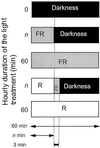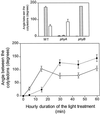Different phototransduction kinetics of phytochrome A and phytochrome B in Arabidopsis thaliana
- PMID: 9536072
- PMCID: PMC35062
- DOI: 10.1104/pp.116.4.1533
Different phototransduction kinetics of phytochrome A and phytochrome B in Arabidopsis thaliana
Abstract
The kinetics of phototransduction of phytochrome A (phyA) and phytochrome B (phyB) were compared in etiolated Arabidopsis thaliana seedlings. The responses of hypocotyl growth, cotyledon unfolding, and expression of a light-harvesting chlorophyll a/b-binding protein of the photosystem II gene promoter fused to the coding region of beta-glucuronidase (used as a reporter enzyme) were mediated by phyA under continuous far-red light (FR) and by phyB under continuous red light (R). The seedlings were exposed hourly either to n min of FR followed by 60 minus n min in darkness or to n min of R, 3 min of FR (to back-convert phyB to its inactive form), and 57 minus n min of darkness. For the three processes investigated here, the kinetics of phototransduction of phyB were faster than that of phyA. For instance, 15 min R h-1 (terminated with a FR pulse) were almost as effective as continuous R, whereas 15 min of FR h-1 caused less than 30% of the effect of continuous FR. This difference is interpreted in terms of divergence of signal transduction pathways downstream from phyA and phyB.
Figures






References
-
- Ahmad M, Cashmore AR. The pef mutants of Arabidopsis thaliana define lesions early in the phytochrome signaling pathway. Plant J. 1996;10:1103–1110. - PubMed
-
- Botto JF, Sánchez RA, Casal JJ. Role of phytochrome B in the induction of seed germination by light in Arabidopsis thaliana. J Plant Physiol. 1995;l46:307–312.
-
- Braslavsky SE, Gärtner W, Schaffner K. Phytochrome photoconversion. Plant Cell Environ. 1997;20:700–706.
-
- Clack T, Mathews S, Sharrock RA. The phytochrome apoprotein family in Arabidopsis is encoded by five genes: the sequences and expression of PHYD and PHYE. Plant Mol Biol. 1994;25:413–427. - PubMed
Publication types
MeSH terms
Substances
LinkOut - more resources
Full Text Sources
Other Literature Sources
Molecular Biology Databases

